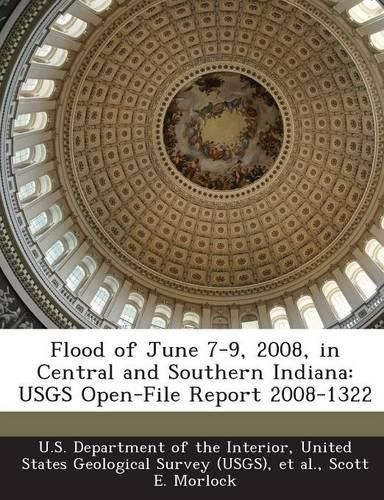Readings Newsletter
Become a Readings Member to make your shopping experience even easier.
Sign in or sign up for free!
You’re not far away from qualifying for FREE standard shipping within Australia
You’ve qualified for FREE standard shipping within Australia
The cart is loading…






On June 6-7, 2008, heavy rainfall of 2 to more than 10 inches fell upon saturated soils and added to already high streamflows from a wetter than normal spring in central and southern Indiana. The heavy rainfall resulted in severe flooding on many streams within the White River Basin during June 7-9, causing three deaths, evacuation of thousands of residents, and hundreds of millions of dollars of damage to residences, businesses, infrastructure, and agricultural lands. In all, 39 Indiana counties were declared Federal disaster areas. U.S. Geological Survey (USGS) streamgages at nine locations recorded new record peak streamflows for the respective periods of record as a result of the heavy rainfall. Recurrence intervals of flood-peak streamflows were estimated to be greater than 100 years at five streamgages and 50-100 years at two streamgages. Peak-gage-height data, peak-streamflow data, and recurrence intervals are tabulated for 19 USGS streamgages in central and southern Indiana. Peak-streamflow estimates are tabulated for four ungaged locations, and estimated recurrence intervals are tabulated for three ungaged locations. The estimated recurrence interval for an ungaged location on Haw Creek in Columbus was greater than 100 years and for an ungaged location on Hurricane Creek in Franklin was 50-100 years. Because flooding was particularly severe in the communities of Columbus, Edinburgh, Franklin, Paragon, Seymour, Spencer, Martinsville, Newberry, and Worthington, high-water-mark data collected after the flood were tabulated for those communities. Flood peak inundation maps and water-surface profiles for selected streams were made in a geographic information system by combining the high-water-mark data with the highest-resolution digital elevation model data available.
$9.00 standard shipping within Australia
FREE standard shipping within Australia for orders over $100.00
Express & International shipping calculated at checkout
On June 6-7, 2008, heavy rainfall of 2 to more than 10 inches fell upon saturated soils and added to already high streamflows from a wetter than normal spring in central and southern Indiana. The heavy rainfall resulted in severe flooding on many streams within the White River Basin during June 7-9, causing three deaths, evacuation of thousands of residents, and hundreds of millions of dollars of damage to residences, businesses, infrastructure, and agricultural lands. In all, 39 Indiana counties were declared Federal disaster areas. U.S. Geological Survey (USGS) streamgages at nine locations recorded new record peak streamflows for the respective periods of record as a result of the heavy rainfall. Recurrence intervals of flood-peak streamflows were estimated to be greater than 100 years at five streamgages and 50-100 years at two streamgages. Peak-gage-height data, peak-streamflow data, and recurrence intervals are tabulated for 19 USGS streamgages in central and southern Indiana. Peak-streamflow estimates are tabulated for four ungaged locations, and estimated recurrence intervals are tabulated for three ungaged locations. The estimated recurrence interval for an ungaged location on Haw Creek in Columbus was greater than 100 years and for an ungaged location on Hurricane Creek in Franklin was 50-100 years. Because flooding was particularly severe in the communities of Columbus, Edinburgh, Franklin, Paragon, Seymour, Spencer, Martinsville, Newberry, and Worthington, high-water-mark data collected after the flood were tabulated for those communities. Flood peak inundation maps and water-surface profiles for selected streams were made in a geographic information system by combining the high-water-mark data with the highest-resolution digital elevation model data available.